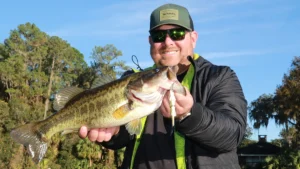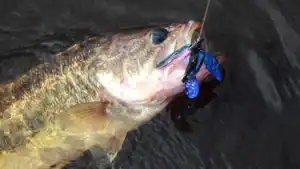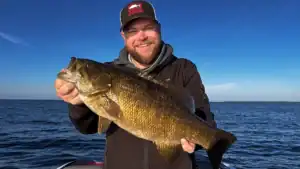We recently had the chance to sit down with noted smallmouth and big water expert Joe Balog about the differences between largemouth and smallmouth crankbait techniques. Joe has won in excess of $250,000 dollars fishing the Great Lakes and is a past Everstart and BASS Open winner. He is a designer and has created several lures and products specifically for the Great Lakes, including the first ever goby lure. He provides some excellent insights into subtle differences between the two species, and how small changes in approach for smallmouth cranking can pay dividends and help put more bronzebacks in the boat.
W2F: When is the best time to use crankbaits on the Great Lakes?
Balog: Crankbait fishing for smallmouth on the Great Lakes can be very good throughout the year. In the spring, we get a shallow movement of fish, and cold water cranking comes into play. Summertime brings is the time of the year that roaming fish play in Lake Erie and St. Clair, and true deep diving crankbaiting is the name of the game. It’s much like ledge fishing in the south. Fall brings baitfish migrations to river mouths, like the Detroit River, and crankbaits play a key role. I really got into this technique around 2000 and use crankbaits a lot more now.
W2F: Are there big differences between largemouth and smallmouth cranking methods?
Balog: A long time ago, I realized that a majority of today’s press and ‘pro tips’ revolve around largemouth bass, usually pretty average in size, and often in shallow water. The Great Lakes smallmouth is a totally different fish and demands a different approach to both techniques and tackle. The reason so many people lose so many smallmouth, specifically to jumps, is due to the use of largemouth tackle. We will discuss that further in a minute.
W2F: What are the key bait variables that make the Great Lakes so much different cranking?
Balog: When cranking the Great Lakes there is one primary factor that has nothing to do with the fish. It’s wind. Because the Great Lakes are so much larger you can fish with the trolling motor on high, for eight hours, and fish less than half of the lake. Wind can be a huge factor so you need a bait that throws well as well as fishes well. If I can’t pick up a bait and throw most of the line off of the spool I won’t use it. Because of that I keep my bait to the DT Series by Rapala. I throw the DT 6, 10, 14, and 16 depending on the time.
W2F: What colors do you use?
Balog: I really like basic colors. I like real pale and baitfish colors for most situations. If there is any stain I always make sure that chartreuse in there. I will add a chartreuse strike on shad baits and like the Rapala Pearl Gray or Perch. I will on occasion throw a DT6 in white with a green back. For some reason, that little green lure really catches the smallmouth, especially on St. Clair.
W2F: What types of action do you like in your crankbaits for smallmouth? Is it different?
Balog: Smallmouth like crankbaits that swim, rather than wobble so most baits with wide wobbles don’t work very well. I also like to use fluorocarbon. I use Sufix 10-pound test for most situations.
W2F- Are there other variables with the crankbaits that make a difference?
Balog: A big key to the system is the hooks and rod. Like I said earlier, I don’t buy into the whole largemouth “system” for cranking 5-pound plus smallmouth in waters with 5 foot waves. I have always used a long graphite rod for cranking smallmouth. I am 100% positive that a graphite rod will land more fish than a fiberglass rod when cranking aggressive smallmouth. Smallmouth often hit a bait at funny angles, pushing it, ramming into it and thrashing it. You need a rod with a little backbone to hook them.
My personal choice is a Daiwa Steez Flex-Lite, and I specifically like a rod longer than 7 feet. I like a little give in the rod for fighting the fish, but I don’t believe a whippy noodle helps with smallmouth. A medium action rod is the best. Because smallmouth have a small mouth and don’t inhale the bait most are hooked outside the mouth. You MUST have a rod capable of hooking those fish from a long distance. I believe the best place to hook them is outside the mouth just behind the chin. They never come off hooked that way.
I always use round bend, super sharp hooks, and I use fairly large hooks. I upsize my hooks one size most of the time. I use No. 2 VMC and No. 4 trebles most of the time. I like a thin wire hook and never use the heavy gauge hooks that are popular now. I think the small wire penetrates better.
I use a Daiwa T3 Ballistic reel due to its design. I feel I can outcast any reel available. I like a 6.3:1 gear ratio. I like to feel the bait and the slower reels don’t allow for that.
W2F- What other tips do you have for retrieves and fighting the fish?
Balog: When cranking smallmouths, I often feel them hit it two or three times before hooking them. In my opinion, you must be able to feel that. When that happens, I usually speed up the retrieve for a crank or two, then pause or slow it down.
When fighting the fish, I fight them aggressively. I like to stay in control without pulling so hard that the hooks pull free. I will occasionally free spool a big one by the boat when they pull hard but do not use the reel’s drag very much. I also try to carry a fairly large net, especially on Erie. I use a big walleye style net with an extension handle. It makes it easy for me and my co-anglers to net fish down on the floor of the boat and keeps us in a more stable spot when it’s really rough.













